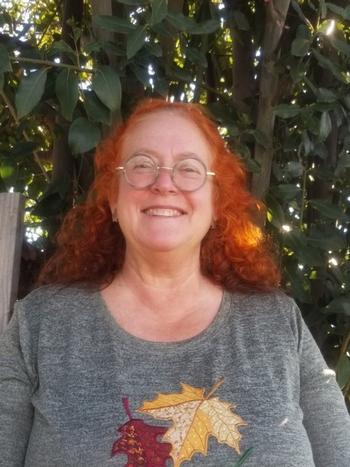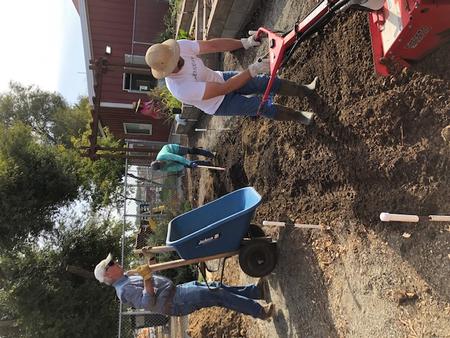The Latest Dirt - Nov 2022
Rivertown Demo Garden Gets a Makeover
By David George

I caught up with busy Lisa Bramblet the other day to talk about all of the exciting changes that are happening or are about to happen at the Rivertown Demonstration Garden. Lisa is a co-lead this year, along with Ken Studer and Mark Thomason, for our East County demonstration garden, formerly known as “Mangini.” I asked about her history with the UC Master Gardener program, the current work reinvigorating the planting beds, and her suggested vision to turn Rivertown into a first-rate public demonstration garden.
DG: What did you do before the UC Master Gardener program, Lisa?
LB: Well, I worked in commercial real estate management and then in the recycling industry for years. I became a ‘Certified Garbologist,’ no joke! (Laughs.) But I’ve enjoyed gardening since I was a kid and was a member of the East County Delta Informal Gardeners club, ‘DIG’ for short. In 2007, I read a notice that the Contra Costa County Master Gardeners New Volunteer Training would be held that year in Antioch. I was so excited and always wanted to be a CoCoMG volunteer, so I applied immediately and was certified with the Class of 2008. I ran the Pittsburg Farmers Market Ask A Master Gardener booth until 2018, and I’m still active in the School Gardens program out this way.
DG: What inspired you to take on a leadership role at Rivertown?
LB: My friend and fellow CoCoMG Muriel Hilliard was basically responsible for the garden as it is currently. She inspired me to get more active at Rivertown. I greatly admired Muriel, but unfortunately, she passed away last year. I wanted to step up my role to honor her memory. I enjoy working alongside Ken and Mark as a co-lead. My responsibilities have changed over the years and is now focused on the planting beds. For years, Rivertown has contributed to the Great Tomato Plant Sale by growing and propagating veggies from seed. It’s fun and rewarding working with quality seeds to grow these great plants from virtually nothing. I love it. But that is how we discovered that we had a problem to solve with our growing beds.

DG: What kinds of problems did you run into, and how did you resolve them?
LB: After several years of propagating plants for the GTPS, our plantings began to fail. Our seedlings were not looking as healthy or vigorous as past years. In 2021, whole beds failed. We had many lively ‘debates’ about what might have caused this. But the only way to know for certain was to deconstruct the beds. In our digging, we found horrendous amounts of polyester weed-block fabric and road-base gravel in multiple layers separating the topsoil from the native soil. We decided to tear down all planting beds and start over.
DG: How is the makeover effort going so far?
LB: Pretty well but it’s a lot of work. These were 2.5 foot raised beds. First, we had to dig out the topsoil, weed fabric and gravel until we reached native soil. We retained the topsoil to replace later. Since the native soil was so compacted and full of tree roots, Tom and Mark had to organize a lot of rototilling. During rototilling, garden volunteers reintroduced the retained topsoil, and then about 4 inches of chopped up plant material for in-ground composting. Then another 4 inches of retained topsoil was added on top, and the beds were heavily watered and covered with moist recycled coffee bags to speed composting.
DG: Sounds like a lot of work! What are the main challenges with the makeover going forward, and what are some of the new ideas for Rivertown?
LB: Mostly we need a lot more volunteers to help with the heavy lifting tasks. More rototilling, trenching and installation of a new irrigation system, shoveling, new planting bed walls, raking, new water lines and spigots. It’s tough work but really rewarding when you see the final product. The Rivertown garden is basically where Our Garden in Walnut Creek was in 2008. So, there is an opportunity for newer UC Master Gardeners to be a part of building the new Rivertown. We have plants for a new and better native plants section, a decorative but fully functional native bee hotel (a gift), and demonstration beds built with different techniques. We have an amazing wonderland of ideas to make the garden more attractive and educational for the East County communities, such as a recirculating waterfall in the back and succulent displays. The whole garden will be submitted for certification as a wildlife habitat. Rivertown is being totally reimagined. But we need more volunteers to help turn these ideas into reality. It’s rewarding and great exercise at the same time!”
DG: Wow, Lisa those are exciting ideas and plans. Thanks for co-leading such a timely effort. I know more Contra Costa UC Master Gardeners will be inspired by your plans and sign up for your work parties to help make it happen.
